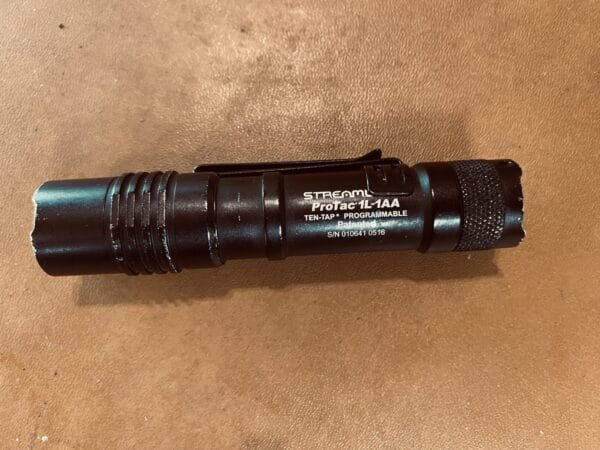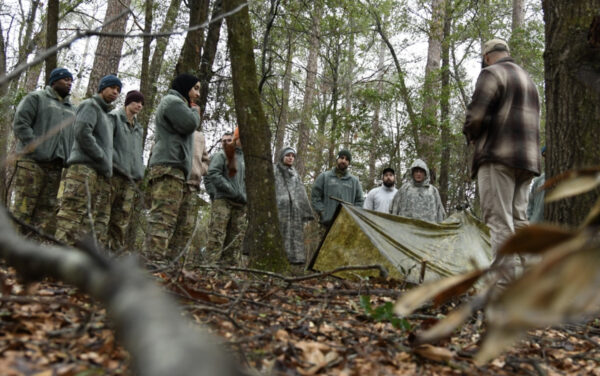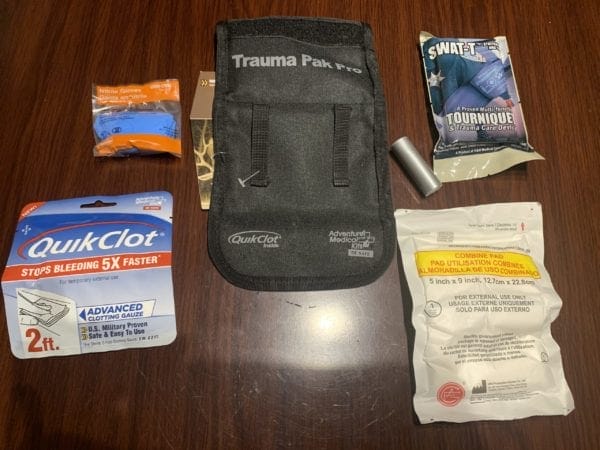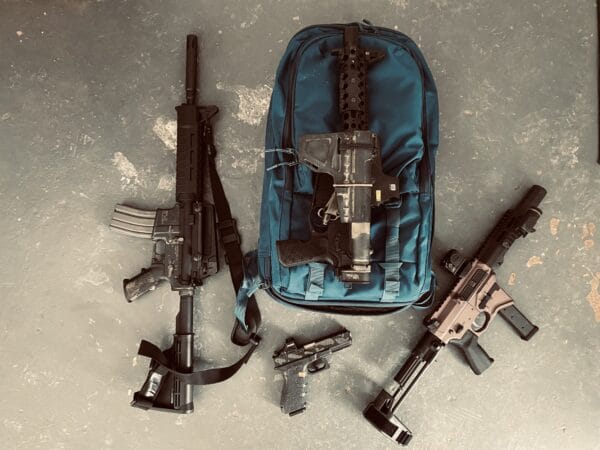This article first appeared on AmmoLand News on February 14th, 2025 and appears here now with fresh updates.

When disaster strikes, you won’t have time to pack—your go bag must be ready now. But not all emergencies look the same, and where you live plays a huge role in what you’ll need to survive.
If you’re in the city, your biggest concerns might be navigating chaos, avoiding threats, and finding shelter fast. In a rural setting, self-sufficiency is key, and you’ll likely be covering more ground with fewer resources available. Each environment demands a different approach, and the gear in your bag should reflect that.
Let’s break down what you really need in an urban vs rural go bag so you’re not caught off guard when things go sideways.
Urban Go Bag Essentials
When you live in an urban environment, your go-bag needs to prioritize mobility, discretion, and adaptability. Cities present unique challenges—crowded streets, potential civil unrest, and limited access to clean water. Your bag should help you navigate obstacles quickly while blending in, keeping you from becoming a target.
Choosing the Right Bag
Your go bag shouldn’t scream “tactical.” A low-profile, nondescript backpack or sling pack is ideal—think grey, black, or dark blue. Something like the Lowe Alpine backpack works well. If you’re moving through a crowded city, a sling bag can provide quick access to essential gear without slowing you down.
Water: Stay Hydrated, Stay Moving
Access to clean water can disappear fast in an emergency. Carry at least one bottle (like a Nalgene Bottle) and have a way to purify more. Water purification tablets and a Grail Geopress water bottle are solid backup options. Hydration packets like Drip Drop Hydration or LMNT electrolyte drink mix can keep your energy levels up.
Food: Keep It Lightweight
You don’t need a feast—just enough calories to keep moving. MREs are a good option if you strip them down to the essentials. Alternatively, use nutrient-dense protein bars such as Cliff bars.
Navigation & Communication
Cell networks go down, batteries die, and Google Maps isn’t always an option. Keep a paper map of your city and a compass in your bag. Your phone is still a valuable tool, so carry a battery pack and a charging cable to keep it powered.
White Light
A reliable flashlight is a must. The Streamlight 1L-1AA, Surefire EDCL1-T, and a Black Diamond headlamp offer solid options. Keep a few chem lights on hand for low-profile illumination or signaling.

Medical: Be Ready for Anything
Your kit should handle everything from minor cuts to life-threatening injuries. At a minimum, pack an IFAK, band-aids, alcohol swabs, and Neosporin. Add a tourniquet and trauma bandages.
Protection & Self-Defense
If things get bad, you may need to defend yourself. A pistol (if legally allowed), a knife, or even a tactical pen or handheld flashlight can provide an extra layer of security. Always keep these items on your person, not in the bag, since bags can be lost or stolen.
Miscellaneous but Critical Gear
- Multitool – A must for quick fixes.
- 550 Cord & Zip Ties – Useful for securing gear or makeshift repairs.
- Riggers Tape & Electrical Tape – Patch, secure, or mark items.
- Sharpies – Mark important info or leave messages.
- Gloves – Protect your hands during debris clearing or self-defense.
- Breaching Tools – Useful for escape and evasion from a deadly situation. This could be a small pair of bolt cutters, compact pry bar, or lock bypass tools.
Clothing: Be Ready for Any Weather
The proper clothing will keep you moving, not slow you down. A lightweight rain jacket, puff jacket, and a wool beanie provide layering options. Your shoes matter—if you’re in dress shoes all day, consider packing a small, lightweight pair of trail runners in your bag.
Blending In: The Gray Man Concept
One of the most critical aspects of an urban go bag is staying unnoticed. Avoid tactical-looking bags, bright colors, or anything that makes you look “prepared.” The goal is to look like just another person moving through the city—not a target.
Rural Go Bag Essentials
Surviving in a rural setting requires a different approach. Unlike the city, where mobility and discretion are key, rural environments demand self-sufficiency, durability, and the ability to navigate long distances on foot. Your gear must support you in potentially harsh terrain, with fewer resources available and longer gaps between resupply points.
Choosing the Right Bag
A durable, comfortable backpack is non-negotiable. You may be carrying heavier loads over uneven terrain, so a well-fitted pack like the Lowe Alpine backpack is a solid choice. Earth-tone colors—green, brown, or gray—help you blend into the environment, keeping you low-profile.
Water: Find, Carry, and Purify
Unlike an urban setting where water sources are often contaminated, rural environments provide more access to streams and lakes—but that water isn’t always safe to drink. Carry at least one bottle (like a Nalgene Bottle or Smart Water bottle) and have multiple ways to purify water:
- Grayl water purifier – Quickly filters out contaminants.
- Stainless Steel Water Bottle and canteen cup – Allows for boiling water in a pinch.
- Water purification tablets – A lightweight backup option.
Food: Calories That Keep You Moving
You’ll likely be covering more ground in a rural scenario, so calorie-dense food is critical. MREs work, but if weight is a concern, consider lightweight protein sources like beef jerky and Cliff Bars. Pack at least 24 hours of food if your situation requires extended travel.
Shelter & Clothing: Adapt to the Elements
Weather can shift quickly in rural areas, and exposure can be deadly. Your bag should include:
- Lightweight, waterproof outer layer – Keeps you dry in sudden rain.
- Puff Jacket – Provides insulation without taking up much space.
- Extra socks & gloves – Dry feet and warm hands prevent fatigue and injury.
- Buff or wool cap – Retains heat and can be used as a makeshift face covering.
- Snugpak Jungle Bag – Lightweight but effective for overnight warmth.
If an emergency forces you to spend the night outdoors, 550 cord and a small tarp or poncho can create a quick shelter.

Navigation
When cell service is gone, and GPS fails, you’ll need reliable navigation tools to get where you need to go.
- Custom topographical map of your area.
- Quality compass – A must-have for terrain navigation.
- Notebook & pencil – For marking locations, noting landmarks, or leaving messages.
- GPS unit (if available) – A good backup, but don’t rely on it exclusively.
A headlamp and a handheld flashlight are essential if you’re moving at night.
Medical: Be Ready for Emergencies
Rural survival often means more physical exertion and higher risks of injury, so a well-stocked IFAK is crucial. Your kit should include:
- Trauma gear (tourniquet, compression bandages, chest seals).
- Basic first aid (band-aids, alcohol swabs, Neosporin).
- Medications (painkillers, allergy meds, Imodium for stomach issues).

You’re more likely to be alone in a rural setting, so knowing how to use your medical gear is just as important as carrying it.
Fire: Stay Warm, Purify Water, and Cook If Needed
Fire isn’t just for warmth—it’s essential for survival. Your kit should include multiple ways to start a fire:
- Lighter (wrapped in riggers tape) – Easy and quick.
- Waterproof matches – A solid backup.
- Pull Start Firestarter – When you need a fire ASAP, regardless of weather conditions.
A reliable heat source can mean the difference between a miserable and survivable night.
Protection & Tools for Self-Reliance
In a rural setting, your personal protection should extend beyond just self-defense—it should also cover hunting, emergency repairs, and survival tasks.
- Pistol – Compact, reliable, and easy to carry.
- AR-Pistol (if needed) – For extended protection or larger threats.
- Fixed-blade knife – Stronger and more versatile than a folding knife.
- Leatherman Multitool – Covers a wide range of needs.
- Breaching tool – If you need to force entry or clear obstacles.

Miscellaneous Gear That Could Save You
- Rubber bands & zip ties – Quick fixes for broken gear.
- Riggers tape & electrical tape – Patching and securing equipment.
- Sharpies – For marking locations or writing emergency notes.
- Spare batteries – Keep your flashlights and electronics functional.
Final Thoughts on a Rural Go Bag
Rural survival isn’t about speed—it’s about endurance and resourcefulness. You need a bag that supports longer distances, harder terrain, and fewer resupply points. By focusing on water, shelter, navigation, and protection, you can stay prepared for whatever challenges the wilderness throws your way.
Conclusion
A go bag isn’t just about throwing a bunch of gear in a backpack—it’s about having the right tools for your specific environment. Urban and rural survival situations present vastly different challenges, and your bag should be built with those in mind.
In a city, you need to stay mobile, blend in, and have quick access to essentials like water, self-defense tools, and navigation aids. Crowds, potential civil unrest, and limited resources mean your focus should be on getting out fast and staying unnoticed.
In a rural setting, survival is more about self-sufficiency and endurance. Your go bag should be capable of sustaining you for longer periods, with gear to purify water, provide shelter, and navigate terrain where help may be hours—or even days—away.
The bottom line? Know your environment, pack accordingly, and always be ready to adapt. The best go bag isn’t the one with the most gear—it’s the one that gives you the best shot at survival when everything goes sideways.
Tactical Preparedness: What Gear Do You Need in a Civil Unrest Scenario
About Scott Witner
Scott Witner is a former Marine Corps Infantryman with 2ndBn/8th Marines. He completed training in desert warfare at the Marine Air Ground Combat Center, Mountain Warfare and survival at the Mountain Warfare Training Center, the South Korean Mountain Warfare School in Pohang, and the Jungle Warfare school in the jungles of Okinawa, Japan. He now enjoys recreational shooting, trail running, hiking, functional fitness, and working on his truck. Scott resides in Northeastern Ohio.







I am a senior citizen, why would I want to pack a bag and run from my home where all my supplies and food are stored ? No I am staying and defending what’s mine . Call me stubborn because I will not run with a little bag of supplies . When you flee you yield everything you own to the ones your running from . They might get what mine but not without a fight .
I am with Montana454Casull I am not going anywhere. I know who everybody who lives here is and we all trust each other. Where could we go that is better than where we are now. We buy local from farmers and know who has what and who to trade with for what you might need. If you have to run you are already losing.
Do you have some place to go.
Have you made arrangements with family or friends. Do you know people along the way.
Would they expect you, would they have a reason to help you.
It’s a good idea to have a get-home bag that travels with you, and an emergency go bag (house on fire, hurricane, chemical spill) that you can grab on the way out the door in under 30 seconds. That go bag should have a hard drive with all financial records, property deeds, lists/photos/valuation of all inside the house for insurance purposes, in addition to a change of clothes, cash, weapon, sustenance. If you are forced to deal with insuarance, you want as many records and receipts and photos as possible.
It might be hard to go it alone or just with your spouse. If you have communications, that will allow you to work with others. 2m HAM radio could be very useful.
HLB
A friend uses a wheeled softball gear bag for his get home gear bag. He feels it doesn’t pique any undue interest in what might be in the bag. He has a softball bat visible in an outside pocket too. He carries CCW every day but travels for work, medical appointments, grocery shopping etc. and wants to ensure he has the necessary gear to get home should the scenario arise. He keeps the gear in a modified storage space under the rear seat, so it’s not visible to prying eyes. Says he’s never needed it in the 25+ years he’s… Read more »
What are “trail runners?” Not up on the latest footwear.
In a worst case scenario, you will need to prepare well ahead of time by developing and maintaining extreme flexibility so you can bend over and kiss your ass goodbye.